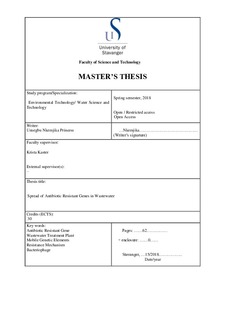| dc.contributor.advisor | Kaster, Krista | |
| dc.contributor.author | Uzuegbu, Nkemjika | |
| dc.date.accessioned | 2018-10-17T06:28:38Z | |
| dc.date.available | 2018-10-17T06:28:38Z | |
| dc.date.issued | 2018-06 | |
| dc.identifier.uri | http://hdl.handle.net/11250/2568344 | |
| dc.description | Master's thesis in Environmental technology | nb_NO |
| dc.description.abstract | The spread of antibiotic resistant genes is of great public health concern. Wastewater treatment plants have been identified as a possible reservoir for these genes. This review gives an overview on the spread of antibiotic resistant genes in wastewater, based on existing data on occurrence of antibiotic as well as mechanisms involved in transfer and spread of resistant genes in wastewater systems. Dispersal of antibiotic resistant genes are facilitated by bacteriophages and mobile genetic elements, such as integrons, plasmids and transposons found in bacteria. Bacteriophage have been found to be extremely important in the spread of resistance genes in wastewater environment. This is due to their abundance in wastewater as well as their ability to transfer and acquire bacteria genes. Studies has shown that antibiotics are present in varying concentrations in distinct wastewater domains such as WWTPs. According to existing data, bacteria in wastewater exhibit resistance phenotype, using resistance mechanisms such as target by-pass, modification of target site, decreased permeability, efflux pumps amongst others. Studies has also shown that plasmids, bacteriophages, integrons and transposons involved in transfer of antibiotic resistant genes, as well as genes encoding other functions are prevalent in wastewater. In vitro studies performed on mobile genetic elements isolated from wastewater showed that mobile elements transmit resistance. The resistant genes are transferred via processes such as conjugation, transduction and transformation. To sum up, antibiotics are present in wastewater domains, and act as selective pressure for the development of resistance in some bacteria. Association of plasmids, integrons, transposons and bacteriophages with bacteria disperses resistant genes in wastewater. Due to the ability of genetic elements to acquire and transfer resistant genes among bacterial population.
| nb_NO |
| dc.language.iso | eng | nb_NO |
| dc.publisher | University of Stavanger, Norway | nb_NO |
| dc.relation.ispartofseries | Masteroppgave/UIS-TN-IKBM/2018; | |
| dc.subject | miljøteknologi | nb_NO |
| dc.subject | water science and technology | nb_NO |
| dc.subject | wastewater treatment | nb_NO |
| dc.subject | wastewater treatment plants | nb_NO |
| dc.subject | antibiotic resistance genes | nb_NO |
| dc.title | Spread of Antibiotic Resistant Genes in Wastewater | nb_NO |
| dc.type | Master thesis | nb_NO |
| dc.subject.nsi | VDP::Teknologi: 500::Miljøteknologi: 610 | nb_NO |
